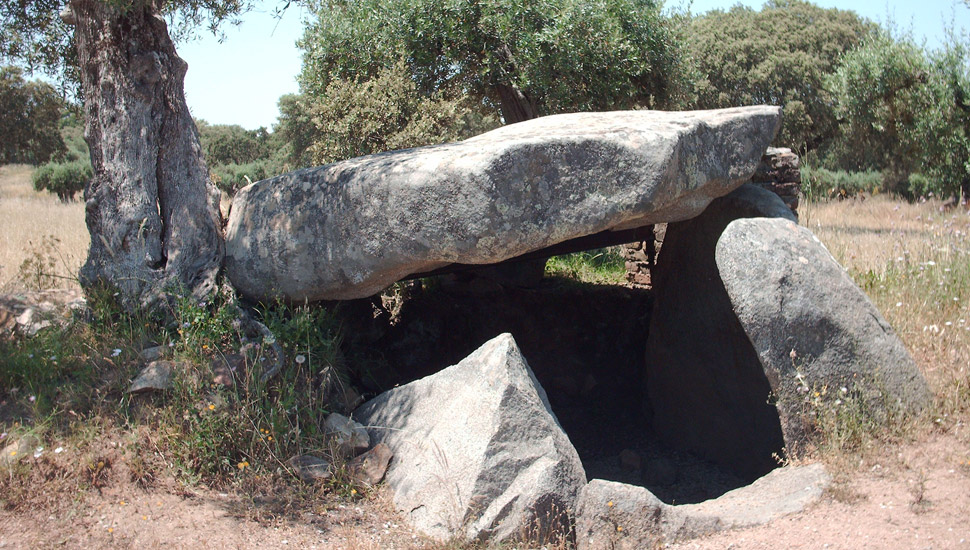Megalithic sites

Megalithic sites
The Alentejo has always attracted people and inspired their beliefs; between 7500 and 4000 years BC, a Neolithic civilization dotted the Alentejo countryside with more than 800 monuments of all sizes. Covered with a stone slab, the dolmens or “antas” – sanctuaries or collective tombs, have very often been erected on hills or near water. The menhirs or “menir”, a characteristic standing stone, evoke by their shape perhaps the first statues representing a human being. Finally, the cromlecs or “cromeleques”, a more or less complex set of stones erected according to a scheme that eludes us, seem to be linked to the stars and seasons.
Cromlech des Almendres: Evora region: it’s undeniably the largest megalithic complex in the entire Iberian peninsula and also one of the oldest in humanity. Its location facing east and its environment in a cork oak forest give it an unique character. The construction of this imposing site spans nearly 3 millennia (late 5th to 3rd millennium BC) with 3 distinct construction phases
-1st phase: construction of 3 concentric circles (6th millennium)
-2nd phase: middle Neolithic: new enclosure made up of 2 concentric and irregular ellipses.
-3rd phase: final Neolithic: addition of other monoliths, some of which have engravings of religious significance.
Menhir des Almendres: 1.3km north-east of Cromlech des Almendres is a large menhir, 3m50 high.
To discover this site, plan to do it early in the morning, sunny days in summer, are particularly hot in this arid climate. A discovery in the heat mists of the early morning is particularly captivating. Good shoes are recommended. Please note that the access “road” is a poorly maintained 5km long track.
Menhir de Belhoa / Bulhoa : municipality of Monsaraz. Discovered overturned in the 1960s, it was straightened and restored in the 1970s. Located on the Telheiro-Outeiro road north of the town of Reguengos de Monsaraz, this menhir is engraved with mysterious circles and lines.
Dolmen (anta grande) of Zambujeiro : this megalithic monument located in Nossa Senhora da Tourega, near Valverde, municipality of Évora, is considered to be one of the largest structures of this type in the entire Iberian Peninsula. The whole is 50m in diameter and includes a polygonal mortuary chamber 6m high as well as a long access corridor . Unfortunately, the interior can’t be visited but you can get an idea of the mortuary room from the back of the monument.
Dolmens de Barrocal: antas Herdade do Barrocal, Evora district: set of 9 dolmens-funeral-neolithic chambers located in Monte do Barrocal but only the number 1 can be visited. Erected between the beginning of the IV th and the middle of the III rd millennium BC, its more than 2meters high with a burial chamber over 3meters in diameter.
Dolmen Olival da Pega: municipality of Reguengos de Monsaraz, district of Évora. This set of 2 dolmens were used for a very long time for the purpose of burial. Over a hundred bodies were buried in each of the 2 dolmens. Many objects were discovered there. Anta 1 is one of the largest dolmens in Portugal; while the mortuary room is large, the access corridor is very narrow. For Anta 2, only the funeral chamber is still visible; a 16m long corridor (the longest in Portugal) connected this dolmen to 4 other surrounding funeral structures.
Cromlech de Xerez: municipality of Monsaraz , this cromlech presents in the center a menhir of 4m high, surrounded by 55 small monoliths forming the sacred enclosure. This cromlech was reconstituted then moved during the impoundment of the nearby Alqueva dam. Located about 3km south of Monsaraz, 100m west of the road connecting Mourão.
Menhir d’Outeiro: municipality of Reguengos de Monsaraz: menhir dating from the Chalcolithic located about 2.5km northeast of Motrinos. This menhir is 5.6meters high; its top has a cup which could represent a urethra. It is one of the tallest megaliths in Portugal.
Dolmen chapelle de S.Dinis (Evora): Evora district: Neolithic dolmen located near the municipality of Mora near the Bairro Coelho Lopes; this dolmen which measures 4.30meters in diameter for a height of 3.30meters is a curious example of the Christianization of a monument considered to be pagan. Its Christianization dates from the 12th century, it was then transformed into a chapel dedicated to Saint Denis.
Dolmen (anta grande) of Zambujeiro: this megalithic monument located in Nossa Senhora da Tourega, near Valverde, municipality of Évora, is considered to be one of the largest structures of this type in the entire Iberian Peninsula. The whole is 50m in diameter and includes a polygonal mortuary chamber 6m high as well as a long access corridor . Unfortunately, the interior can’t be visited but you can get an idea of the mortuary room from the back of the monument.



